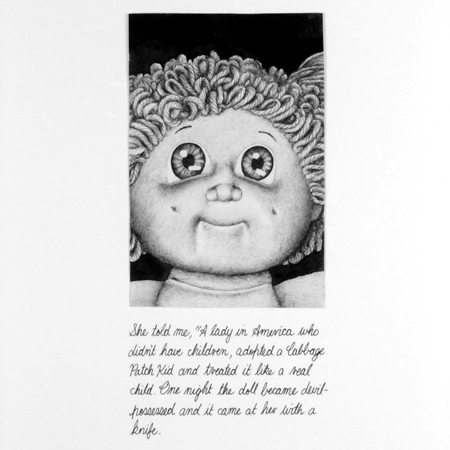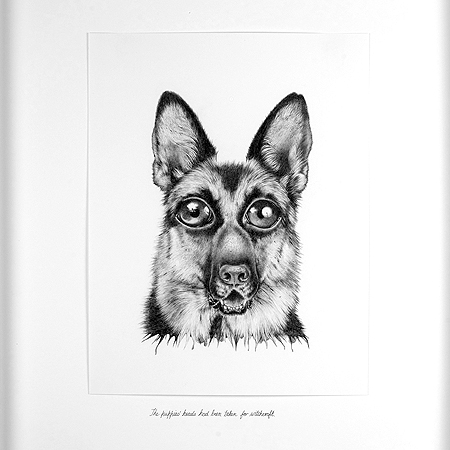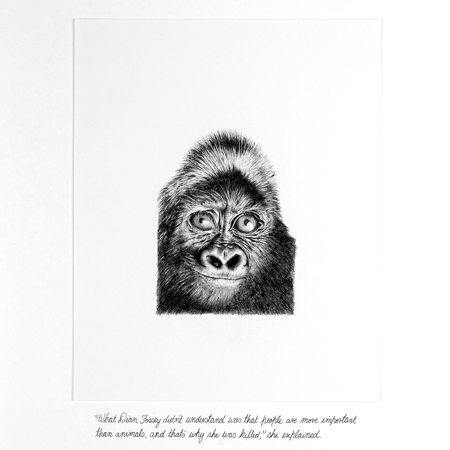
Emma Butler
Self-conscious
Emma Butler’s first solo exhibition, Self-conscious, privileges the memory of childhood events and the sudden shock at the recollection of these memories that can repeat, as vividly as the last, through adulthood. The acquisition of knowledge, and experience, in the transitional stages of late childhood, is seen from an adult’s perspective as an uncanny ability to weigh a situation or explanation and find it worthy of doubt. This period of childhood is webbed with our participation in acts that have consequences. It is also where we recognise that we think differently to parents, family. There comes a sense of difference, of individuality. And alongside other memories, perhaps there is some guilt too, a becoming aware of our complicity in meanness and cruelty; the cruelest realization perhaps is that we once were innocent.
Self-conscious presents a suite of eight works on paper, each comprised of a portrait and a text or narrative fragment. At first glance, these finely rendered drawings, in ballpoint pen, felt-tip and gouache, draw on Butler’s investigation of children’s book illustration. We can see too the wide-eyed manga style of Yoshimoto Nara, or the ‘haptic’ eye of Joy Hester, pulled into a strange melding with traditional, studied markmaking albeit with ready-to-hand materials. Butler’s human subjects are creaturely, and yet her depiction of a gorilla and Alsatian dog, demonstrate a deep awareness of animals as sentient beings, with consciousness, intelligence, emotions, and personalities. This privileging of animals and their value is a recurring theme in Butler’s practice, but in every portrait, whether it be the open, happy, and accepting presence of a Cabbage Patch doll (a marketing product founded upon ‘uniqueness’), a sad or malevolent child, the quiet confidence and wise smile of a gorilla, we encounter an individual who is true to a situation, whose gaze seeks you out, unblinkingly.
Hand-written in cursive felt-tip pen, on the mountboard underneath the portraits, are narrative fragments told in the artist’s childhood voice, Butler’s ‘scarred for life’ fragments are taken from personal experience, and reveal the artists interest in memories as defining the self, memories as ‘scars.’ Remembered and re-told, they tell of Butler’s background as a child of Australian Seventh-Day Adventist missionaries, and growing up in Africa within a context of Christian values and a Biblical education. By the re-counting of specific events, re-quoting what has been said and done, Butler reflects on the significance of childhood events more generally.
In terms of her drawing medium, Butler has explained, “At school, the use of pen marked a level of maturity, a delineated graduation from the more forgiving pencil: no longer were unsatisfactory marks on paper to be erased and re-attempted, they must be accepted, and crossed out, just as the markings of childhood memories might be re-assessed, but not erased.”
There is at least a double-reading required in Butler’s image/text works, as both image and text are active presences. They vie for your attention, against the whole of the work, and in doing so effect a kind of value-adding to the other while illustrating the gap between those two forms of acquired language.
Butler’s talent is apparent in the subtlety of her rendering—the turns in the corner of a lip, the incredible detail as she handles the wet orb of an eye, in the soft fuzz or intricacy of hair. But most significantly, she captures individual beings and specific emotions in such a way that privileges empathy—her exquisite markmaking and narrative texts are secondary to the overall importance of feeling.
Naomi Evans
Sydney, February 2008


